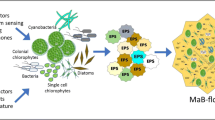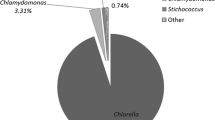Abstract
Microalgal-bacterial (MaB) flocs are a promising route towards sustainable wastewater treatment, but the effects of algal species and algal abundance on MaB floc function are not yet understood. MaB flocs were created by inoculating activated sludge with several species of algae at different initial algal to bacterial biomass ratios (5:1, 2:1, 1:1, or 1:5 algae:activated sludge) to determine the effects on nutrient removal, lipid content, microalgal-bacterial bioflocculation rates, and settleability. The algal species Chlorella vulgaris, Chlorella sorokiniana, Scenedesmus dimorphus, and Neochloris oleoabundans all formed MaB flocs within 2 h of inoculation with activated sludge. Chlorella vulgaris formed MaB flocs with the highest lipid content (11.1%), followed by S. dimorphus (8.2%), and N. oleoabundans (6.4%), for MaB flocs inoculated at 1:1 algae:activated sludge (w/w) ratio. Chlorella vulgaris incorporated into activated sludge to form MaB flocs to the greatest extent, and C. sorokiniana the least. Phosphorus removal was influenced by the species of microalgae used for MaB floc inoculum, with S. dimorphus showing highest P removal of up to 92–97% at 5:1 and 2:1 algae:activated sludge (w/w) ratios.




Similar content being viewed by others
Data availability
All data and material are available upon request.
References
Arcila JS, Buitrón G (2017) Influence of solar irradiance levels on the formation of microalgae-bacteria aggregates for municipal wastewater treatment. Algal Res 27:190–197
Cazzaniga S, Dall’Osto L, Szaub J, Scibilia L, Ballottari M, Purton S, Bassi R (2014) Domestication of the green alga Chlorella sorokiniana: reduction of antenna size improves light-use efficiency in a photobioreactor. Biotechnol Biofuels 7:157
Chisti Y (2008) Biodiesel from microalgae beats bioethanol. Trends Biotechnol 26:126–131
Collotta M, Champagne P, Mabee W, Tomasoni G, Leite GB, Busi L, Alberti M (2017) Comparative LCA of flocculation for the harvesting of microalgae for biofuels production. Procedia CIRP 61:756–760
de Bruin LMM, de Kreuk MK, van der Roest HFR, Uijterlinde C, van Loosdrecht MCM (2004) Aerobic granular sludge technology: an alternative to activated sludge? Water Sci Technol 49:1–7
Doane TA, Horwath WR (2003) Spectrophotometric determination of nitrate with a single reagent. Anal Lett 36:2713–2722
Eaton AD, Clesceri LS, Greenberg AE, Franson MAH (1998) Standard methods for the examination of water and wastewater, 15th edn. American Public Health Association, American Water Works Association, Water Environment Federation, Washington, DC
EPA (2013) Report on the performance of secondary treatment technology. EPA-821-R-13-001
Gao H, Scherson YD, Wells GF (2014) Towards energy neutral wastewater treatment: methodology and state of the art. Environ Sci Process Impacts 16:1223–1246
Gorman DS, Levine RP (1965) Cytochrome f and plastocyanin: their sequence in the photosynthetic electron transport chain of Chlamydomonas reinhardi. Proc Natl Acad Sci 54:1665–1669
Griffiths MJ, Van Hille RP, Harrison STL (2012) Lipid productivity , settling potential and fatty acid profile of 11 microalgal species grown under nitrogen replete and limited conditions. J Appl Phycol 24:989–1001
Guarnieri MT, Nag A, Smolinski SL, Darzins A, Seibert M, Pienkos PT (2011) Examination of triacylglycerol biosynthetic pathways via de novo transcriptomic and proteomic analyses in an unsequenced microalga. PLoS One 6:e0025851
Gutzeit G, Lorch D, Weber A, Engels M, Neis U (2005) Bioflocculent algal-bacterial biomass improves low-cost wastewater treatment. Water Sci Technol 52:9–18
Hu Y, Hao X, van Loosdrecht M, Chen H (2017) Enrichment of highly settleable microalgal consortia in mixed cultures for effluent polishing and low-cost biomass production. Water Res 125:11–22
Khaldi H, Maatoug M, Dube CS, Ncube M, Tandlich R, Heilmeier H, Laubscher RK, Dellal A (2017) Efficiency of wastewater treatment by a mixture of sludge and microalgae. J Fundam Appl Sci 9:1454–1472
Krustok I, Odlare M, Shabiimam MA, Truu J, Truu M, Ligi T, Nehrenheim E (2015) Characterization of algal and microbial community growth in a wastewater treating batch photo-bioreactor inoculated with lake water. Algal Res 11:421–427
Leong WH, Lim JW, Lam MK, Uemura Y, Ho CD, Ho YC (2018) Co-cultivation of activated sludge and microalgae for the simultaneous enhancements of nitrogen-rich wastewater bioremediation and lipid production. J Taiwan Inst Chem Eng 87:216–224
Letcher PM, Lopez S, Schmieder R, Lee PA, Behnke C, Powell MJ, McBride RC (2013) Characterization of Amoeboaphelidium protococcarum, an algal parasite new to the Cryptomycota isolated from an outdoor algal pond used for the production of biofuel. PLoS One 8:e56232
Liu L, Fan H, Liu Y, Liu C, Huang X (2017) Development of algae-bacteria granular consortia in photo-sequencing batch reactor. Bioresour Technol 232:64–71
Mayew P, Cuhel R, Nyholm N (1997) A simple in vitro fluorescence method for biomass measurement in algal growth inhibition tests. Water Res 31:2525–2531
Menetrez MY (2012) An overview of algae biofuel production and potential environmental impact. Environ Sci Technol 46:7073–7085
Mishra SK, Suh WI, Farooq W, Moon M, Shrivastav A, Park MS, Yang JW (2014) Rapid quantification of microalgal lipids in aqueous medium by a simple colorimetric method. Bioresour Technol 155:330–333
Nalley JO, Stockenreiter M, Litchman E (2014) Community ecology of algal biofuels: complementarity and trait-based approaches. Ind Biotechnol 10:191–201
Nichols HW (1973) Growth media-freshwater. In: Stein JR (ed) Handbook of phycological methods - culture methods and growth measurements. Cambridge University Press, London, pp 7–24
OECD/OCDE (2001) OECD guideline for the testing of chemicals
Stockenreiter M, Haupt F, Seppälä J, Tamminen T, Spilling K (2016) Nutrient uptake and lipid yield in diverse microalgal communities grown in wastewater. Algal Res 15:77–82
Su Y, Mennerich A, Urban B (2012) Synergistic cooperation between wastewater-born algae and activated sludge for wastewater treatment: Influence of algae and sludge inoculation ratios. Bioresour Technol 105:67–73
Van Den Hende S, Carré E, Cocaud E, Beelen V, Boon N, Vervaren H (2014) Treatment of industrial wastewaters by microalgal bacterial flocs in sequencing batch reactors. Bioresour Technol 161:245–254
Wang B, Lan CQ (2011) Biomass production and nitrogen and phosphorus removal by the green alga Neochloris oleoabundans in simulated wastewater and secondary municipal wastewater effluent. Bioresour Technol 102:5639–5644
Welter C, Schwenk J, Kanani B, Van Blargan J, Belovich J (2013) Minimal medium for optimal growth and lipid production of the microalgae Scenedesmus dimorphus. Environ Prog Sustain Energy 32:937–945
Xu M, Xu S, Bernards M, Hu Z (2016a) Evaluation of high density algal cultivation for secondary wastewater polishing. Water Environ Res 88:47–53
Xu Y, Wang Y, Yang Y, Zhou D (2016b) The role of starvation in biomass harvesting and lipid accumulation: co-culture of microalgae-bacteria in synthetic wastewater. Environ Prog 35:103–109
Acknowledgments
Thanks to Brian Flanagan at Southerly Wastewater Treatment Plant with the Northeast Ohio Regional Sewer District for obtaining activated sludge. Thanks to Nicholas Merchant-Wells and Aaron Mann for performing additional analyses.
Author information
Authors and Affiliations
Contributions
All authors contributed to the study conception and design. Material preparation, data collection, and analysis were performed by Mark Loria. The first draft of the manuscript was written by Mark Loria and all authors commented on previous versions of the manuscript. All authors read and approved the final manuscript.
Corresponding author
Ethics declarations
Conflict of interest
The authors declare that they have no conflict of interest.
Additional information
Publisher’s note
Springer Nature remains neutral with regard to jurisdictional claims in published maps and institutional affiliations.
Supplementary Information
ESM 1
(DOCX 388 kb)
Rights and permissions
About this article
Cite this article
Loria, M.H., Wells, G.F. & Rhoads, K.R. Influence of algal strain on microalgal-bacterial bioflocculation rate and floc characteristics. J Appl Phycol 33, 777–784 (2021). https://doi.org/10.1007/s10811-021-02378-3
Received:
Revised:
Accepted:
Published:
Issue Date:
DOI: https://doi.org/10.1007/s10811-021-02378-3




